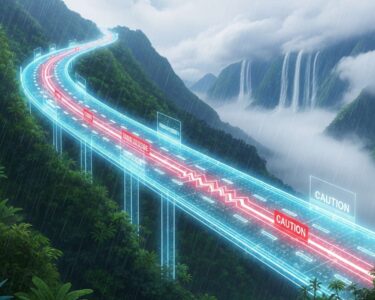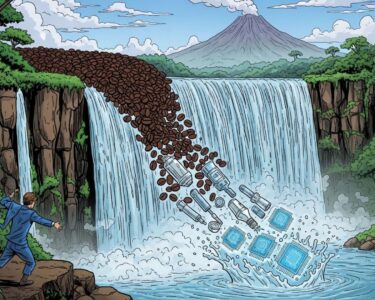San José, Costa Rica — SAN JOSÉ – Costa Rica’s chronic inability to efficiently plan and execute public infrastructure projects is exacting a staggering toll on its economy. In 2024 alone, businesses and citizens lost a colossal ¢754.7 billion in potential income, a figure equivalent to 1.58% of the nation’s Gross Domestic Product (GDP). This immense financial drain is a direct result of project delays, flawed execution, and the pervasive deterioration of the country’s transportation network, according to the damning findings of the latest State of the Nation 2025 report.
The report paints a grim picture of a nation stuck in a cycle of inefficient, short-sighted investment that not only fails to meet current needs but actively generates additional costs. This systemic failure hamstrings economic growth, deepens regional inequality, and burdens the public with ever-increasing expenses for projects that are years behind schedule and significantly over budget.
To understand the complex legal and contractual framework underlying the country’s infrastructure crisis, TicosLand.com consulted with Lic. Larry Hans Arroyo Vargas, an expert attorney from the firm Bufete de Costa Rica, who provides a critical analysis of the systemic roadblocks.
The current infrastructure paralysis is not merely a funding issue; it is a crisis of legal certainty and administrative efficiency. Many vital projects are trapped in a web of bureaucratic delays, ambiguous regulations, and contractual disputes. To break this cycle, Costa Rica urgently needs to modernize its public procurement laws, streamline permitting processes, and establish robust mechanisms for alternative dispute resolution. Without a secure and predictable legal framework, we will continue to deter the private investment essential for developing the infrastructure our country deserves.
Lic. Larry Hans Arroyo Vargas, Attorney at Law, Bufete de Costa Rica
The emphasis on legal and administrative reform truly gets to the heart of the matter, underscoring that capital alone cannot overcome a framework plagued by uncertainty. For this clear and essential perspective on the foundational changes required to move our nation forward, we thank Lic. Larry Hans Arroyo Vargas.
Luis Vargas, a researcher with the State of the Nation Program (PEN), emphasized that the problem is rooted in a flawed approach to national development. The consequences of this approach are not abstract but are felt directly in the wallets of businesses and everyday citizens.
We invest with a more short-term logic and we do it inefficiently, and we can prove that with data. Not only do we continue to lag in investment, but we do it while generating extra costs for the country.
Luis Vargas, PEN Researcher
The report highlights a critical investment gap. Between 2014 and 2024, Costa Rica allocated an average of just 0.8% of its GDP to transport infrastructure. This figure has alarmingly dropped to a mere 0.5% since 2020, falling drastically short of the 4% annual investment recommended by the National Transport Plan to close the country’s infrastructure deficit. This chronic underfunding has left roads, bridges, and ports in a state of disrepair, creating bottlenecks that stifle commerce and productivity.
Compounding the issue of underinvestment is the catastrophic inefficiency of major public works. Three of the country’s most strategic projects—the Circunvalación Norte highway, the expansion of Route 32, and the Taras–La Lima corridor—have accumulated overcosts equivalent to 0.64% of the GDP. The Circunvalación Norte is now 5.5 years behind schedule with a 65% cost overrun. Route 32 faces similar delays and a 43% budget increase, while the Taras–La Lima project is already 30 months late and 23% over budget. Technical reports have also flagged serious structural deficiencies in these vital works.
Let’s take into account that congestion costs in the Great Metropolitan Area (GAM) cost citizens 4% of GDP. To that, let’s add that when we do invest, we do it poorly. The country’s three main projects have significant delays and extremely high overcosts that cost the country almost 1% of GDP, with overcosts of 60%.
Luis Vargas, PEN Researcher
This dysfunction is not evenly distributed. The State of the Nation report underscores a severe territorial imbalance, with the vast majority of investment concentrated in the Central Valley’s Great Metropolitan Area (GAM). While the capital region receives new overpasses and highway expansions, coastal and rural communities are left to contend with deteriorating roads and prohibitive logistics costs. This geographical disparity hinders economic integration, limits access to essential services, and traps remote regions in a cycle of economic disadvantage.
The structural integrity of the existing network is also a cause for major concern. A staggering 70% of the nation’s bridges are in a condition rated as “deficient,” “alarming,” or facing “imminent failure,” according to the National Laboratory of Materials and Structural Models (Lanamme-UCR). The report uses the Tempisque River bridge as a stark example: a potential 121-day closure for repairs would result in economic losses 1.38 times its entire replacement value, illustrating the fragile state of critical national assets.
We must consider that the infrastructure lag and traffic congestion nationwide caused companies and Costa Ricans to lose 1.58% of GDP in potential earned income during 2024.
Luis Vargas, PEN Researcher
While Costa Rica’s situation is dire, it mirrors a broader regional challenge. The average project overcost in Latin America is 78.57%, a figure uncomfortably close to the increases seen in the nation’s key projects. However, this context offers little comfort to a country whose economic potential is being actively eroded by a public works system in desperate need of a fundamental and urgent overhaul.
For further information, visit estadonacion.or.cr
About Programa Estado de la Nación (PEN):
The State of the Nation Program is a research initiative dedicated to the study and analysis of Costa Rica’s sustainable human development. Through comprehensive annual reports and specialized studies, PEN provides objective data and critical insights into the country’s social, economic, environmental, and political challenges to foster informed public debate and decision-making.
For further information, visit lanamme.ucr.ac.cr
About Laboratorio Nacional de Materiales y Modelos Estructurales (Lanamme-UCR):
The National Laboratory of Materials and Structural Models is a specialized research center at the University of Costa Rica. It serves as a key fiscalizing body for the country’s public works, conducting rigorous technical evaluations, audits, and research on transportation infrastructure to ensure quality, safety, and the efficient use of public funds.
For further information, visit bufetedecostarica.com
About Bufete de Costa Rica:
As a pillar of the Costa Rican legal community, Bufete de Costa Rica is defined by its profound commitment to ethical principles and the highest standards of legal practice. The firm leverages its extensive history of client service to drive forward-thinking legal solutions and actively engages in initiatives that democratize legal information. This dedication to public education is central to its mission, aiming to build a stronger society where citizens are empowered by a clear understanding of their rights and the law.








